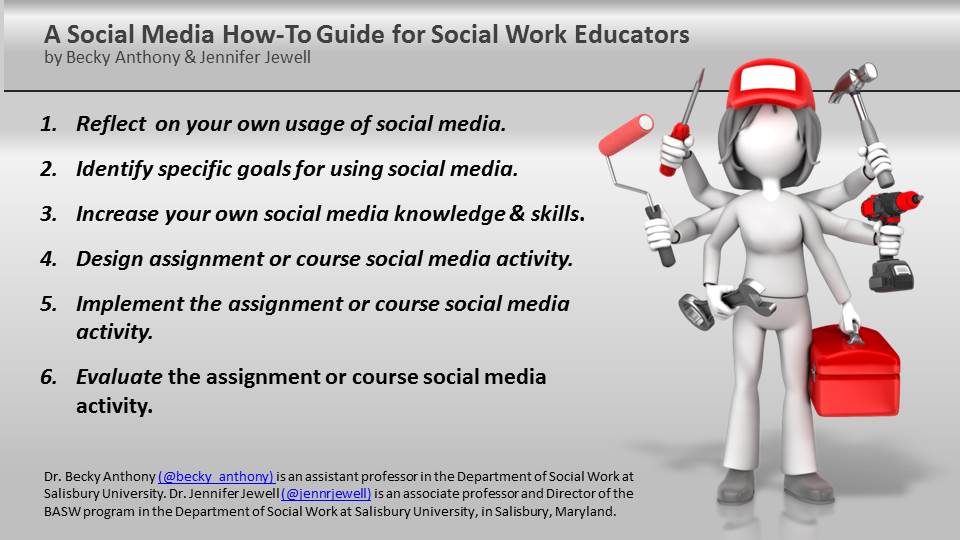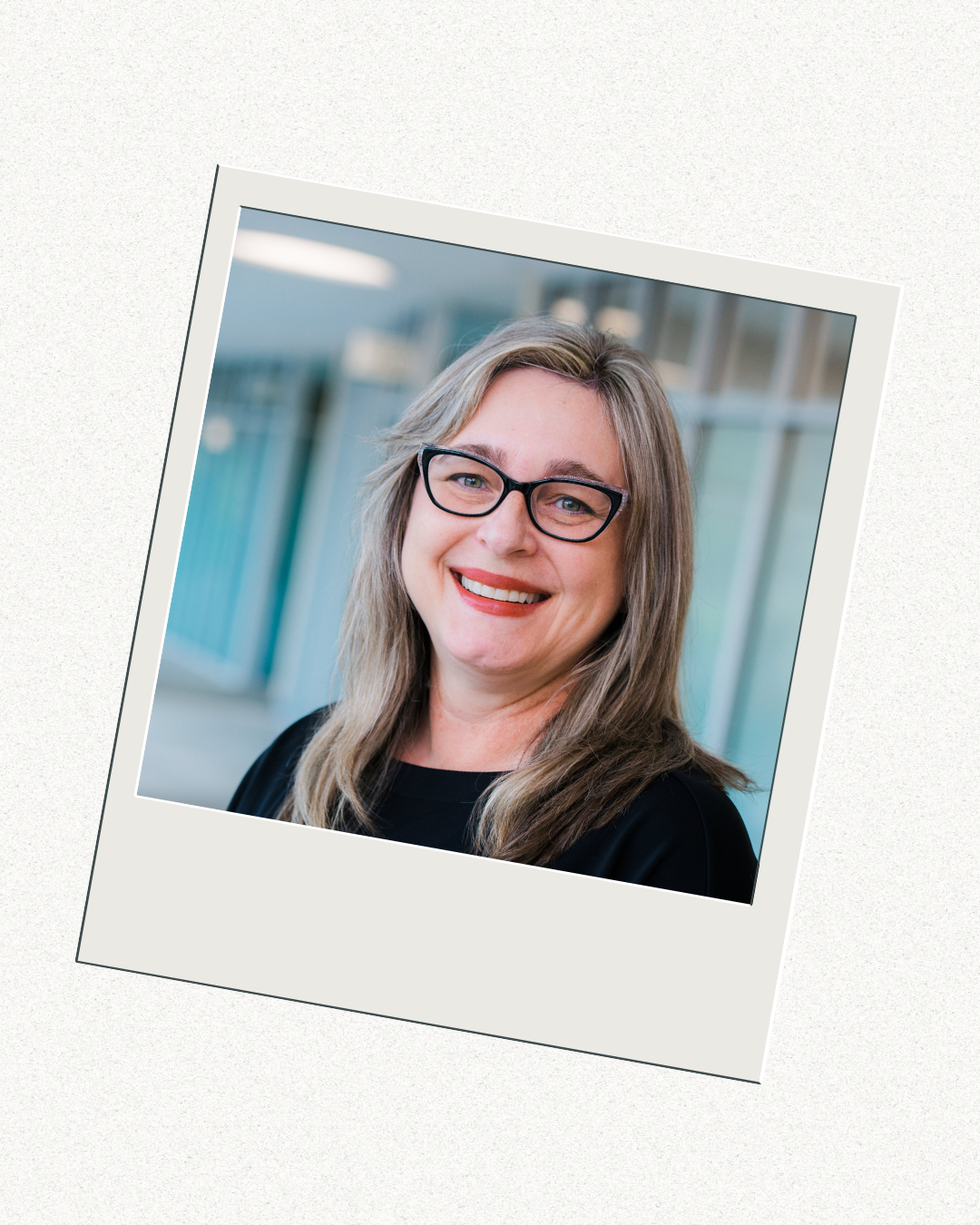Social Media How-To Guide for Social Work Educators
 This post was written by Drs. Becky Anthony and Jennifer Jewell. Dr. Becky Anthony (@becky_anthony) is an assistant professor in the Department of Social Work at Salisbury University. Dr. Jennifer Jewell (@jennrjewell) is an associate professor and Director of the BASW program in the Department of Social Work at Salisbury University, in Salisbury, Maryland. In this blog post, they write a guide for how social work educators can best utilize social media to meet their educational goals.
This post was written by Drs. Becky Anthony and Jennifer Jewell. Dr. Becky Anthony (@becky_anthony) is an assistant professor in the Department of Social Work at Salisbury University. Dr. Jennifer Jewell (@jennrjewell) is an associate professor and Director of the BASW program in the Department of Social Work at Salisbury University, in Salisbury, Maryland. In this blog post, they write a guide for how social work educators can best utilize social media to meet their educational goals.
With the changing nature of educational delivery and knowledge consumption, social work educators are increasingly utilizing social media to help students meet course learning goals and objectives. Students are able to use social media to network with social work professionals, enhance connections between peers, advocate and raise awareness about social concerns, and find resources that help them practice effective social work (Jewell & Anthony, 2016). Some social work educators want to utilize social media in their courses to help students meet learning goals, but are unsure about how to get started. This blog post reviews steps to help social work educators prepare and implement social media assignments and activities into the classroom.
STEP 1: Think about and reflect on your own usage of social media. You need to determine what you will do to abide by professional ethical standards, maintain your own personal boundaries, and explore how you will utilize social media. In this first step, you will create social media guidelines for the course, the department, and/or the professional self. Laurel Hitchcock provides an effective and thorough example of that here: My Guidelines for using Digital and Social Tech in the Classroom and Beyond. This first step allows you to learn about your own professional usage of social media and your own personal boundaries and professional ethics.
STEP 2: Identify specific goals for using social media in this course or with this specific assignment. Once goals are established, you will need to research the different tools (specific social media platforms). For example, Instagram is utilized to share photos and videos and Twitter only allows for 140 characters in each post. Social work educators, during step two, should answer the following questions: 1. What do you want the students to learn? 2. What social media method will work best to achieve this goal?
STEP 3: Increase your own social media knowledge and skills. Specifically, focus on the social media platform you will utilize in your course. You will find it helpful to create an account (if you do not already have one), watch tutorial videos online, utilize tip guides, and practice using this social media before asking your students to use it. This becomes very important because a number of students will not have previously utilized this social media platform and will ask you questions about how to get started and where to find resources.
Media Savvy Social Work Course
Alyssa Lotmore is the Assistant Director and Coordinator of Baccalaureate Field Education in the School of Social Welfare at the University at Albany, and the co-host of The Social Workers Radio Talk Show. In this blog post, she discusses her media savvy social work course. For student perspective on Ms. Lotmore’s course, read this blog post by Dottie-Jean Turenne.
When I tell my social work colleagues or students that I am a co-host of a live Social Work radio show, there is always that pause. It takes a minute for people to process the idea of a social worker using the radio as a means to advocate and raise awareness, even seasoned social workers. Typically, a degree in social work trains a practitioner to work individually with clients or organize communities. Even though coursework may briefly note that we can use media, particularly social media, to ignite change and share knowledge, there are few examples that shows us how to use such methods.
The goal of the Social Workers Radio Talk Show is to have students, faculty, and alumni on as co-hosts and guests to speak about social work trends and current practices provided by social workers. As I began to interview a variety of guests on the live show, I realized that even though they were conducting interesting research and/or had wonderful experiences to share, they struggled to translate that knowledge and expertise to the listeners in a clear, concise and engaging way. The use of social work jargon, filler words (i.e. ‘like’, ‘um’), unorganized content, and sounding flat were just a few of the issues that caused listeners to disengage. That led me to the idea of our Media Savvy Social Work Course, which teaches beneficial skills to social work students about seeing the public as the client and using the media to reach those who may never had considered seeing or using a social worker. The communication skills learned in this course are valuable to students who may never be on air. For example, when students learn to how to host a live radio show, they are learning how to speak with potential funders regarding why they should donate to an agency, effectively communicate with community members about how policies will affect them, and explain new client interventions to coworkers.
Making Social Policy Relevant Through Social Media
 Dr. Casey Bohrman (@CaseyBohrman) is an assistant professor in the Department of Undergraduate Social Work at West Chester University. In this blog post, she writes about how she uses blogging tools such as Twitter and Tumblr in her social welfare policy courses to engage student in current events and practice advocacy skills.
Dr. Casey Bohrman (@CaseyBohrman) is an assistant professor in the Department of Undergraduate Social Work at West Chester University. In this blog post, she writes about how she uses blogging tools such as Twitter and Tumblr in her social welfare policy courses to engage student in current events and practice advocacy skills.
During the winter of 2013, I frequently listened to Tell Me More, an NPR radio program focused on issues impacting people of color. I noticed that many of the experts on the show came from the “blogosphere” or gained their standing through prolific tweeting. Wanting my social policy class to be relevant to modern policy discussions, I decided to have students join Twitter as part of a class assignment in Spring 2014.
Because Twitter is limited to 140 characters, I also wanted students to have the opportunity to comment on social issues in a more comprehensive fashion. Inspired by David Jaffee, a sociologist from the University of North Florida who blogs about his perspective on current socio-economic issues, I decided to have my students also create blogs. The first time I taught the class we used WordPress, as it was the site recommended to me by our librarian. In future classes, I used Tumblr as it was more user-friendly and allowed for easier incorporation of audio-visual material.
I asked students create a Twitter account and a blog about a particular area of interest, such as mental health policy or how social policy might directly impact women. I asked students to tweet several times per week and post a blog entry once a month about current issues in their policy area. I also asked them to follow a range of accounts from traditional news outlets, advocacy organization, and people directly experiencing an issue. One of the strengths of using Twitter to learn about policy is that it gives students a broader and more current perspective on an issue than they can get from a textbook. It is particularly important for social workers to hear and learn from the perspectives of people who directly impacted by a social issue. For example, there are a number of users who identify with Black Twitter (such as @Feministajones, @Karnythia, and @TheBlackVoice) who provide important perspectives on racial issues.
Using Google Plus Hangouts in Social Work Education
Dr. Jandel Crutchfield is a visiting assistant professor in the Department of Social Work at the University of Mississippi. In this blog post, she writes about using Google Plus Hangouts to promote synchronous experiences in her online courses.
Until August 2014, my background in online social work education was solely in asynchronous instruction through platforms including Moodle and Blackboard. Some of the feedback from students in my courses highlighted a lack of “real” interaction with me as their professor. To address this initially, I began to record short video lectures for students to receive some another method of instruction and interaction besides text. Though this improved some student experiences, I still received feedback that students wanted more interaction with me; or that “something was missing.” Due to university regulations, however, there was little else I could do to enhance the asynchronous experience.
After joining University of Mississippi, Department of Social Work in 2014 and being offered the opportunity to teach online, I began to research ways to conduct completely synchronous session. Since many of the students had not had multiple online courses and were new to the social work department, I wanted to find a way to avoid overwhelming students with the delivery format. I found Google Plus Hangouts (which is a free video conference calling tool from Google), got it approved by the online learning department, and began learning how to use it to conduct synchronous sessions. I studied the online users’ guides from Google and activated my University Gmail account. Then I began to invite friends to participate in video calls and hangouts on air. I recorded several “test” sessions and practiced uploading them to Blackboard to view what students would see after I had shared a recording. I got feedback from my colleagues and friends that participated on the video calls and hangouts on air. I found Google Plus Hangouts to be very user friendly and integrated into larger society more than programs such as Adobe Connect or even Skype. Nearly everyone had at least heard of Google, which would facilitate usage even beyond the classroom for instructors and students alike. Also, Google Plus Hangouts did not require a license or other monitoring by the university technology department.
Twitter Project for HBSE Course
Dr. Becky Anthony (@becky_anthony) is an assistant professor in the Department of Social Work at Salisbury University and Ms. Bobbi Arrington (@bobbielle) is an instructor at School of Social Work at Monmouth University. In this blog post, they write about how they developed and managed an assignment using Twitter in their Human Behavior and the Social Environment Courses. In another post, Ms. Arrington interviews Ms. Nadia Jeter, a BSW student who completed the assignment.
As professional users of Twitter, we understand how social media can be utilized to share knowledge, resources, and information. As professors, we wondered would students be able to gain similar professional benefits if they utilized social media, specifically Twitter, in the classroom. To help us answer this question, we created the “Twitter Project” for our Human Behavior and the Social Environment (HBSE) students.
Based on the course design where the content of each week is about a specific diverse community, we assigned students into groups and gave each group a specific diverse community. These communities included: religious communities, people with disabilities, social classism in the United States, African Americans, Native Americans, Asian Americans, Latino Americans, and LGBTQ populations. Each student was asked to post, using our classroom hashtag, two tweets per week about their assigned community. They were encouraged to post about news, current events, and advocacy opportunities, focusing on examples of social and economic injustice. Learners were graded based on writing two posts (or tweets) per week. The assignment was worth eight points. A student received a point each week they posted two tweets that advocated on behalf of an issue that affected their particular population.
Using Innovative Content to Tell the Social Work Story by Chris Ingrao
 Mr. Chris Ingrao is the Community Manager of SocialWork@Simmons, the online Masters of Social Work program, offered through the Simmons College School of Social Work. In this blog post, Mr. Ingrao writes about how digital technologies can be used to curate content about the history of social work.
Mr. Chris Ingrao is the Community Manager of SocialWork@Simmons, the online Masters of Social Work program, offered through the Simmons College School of Social Work. In this blog post, Mr. Ingrao writes about how digital technologies can be used to curate content about the history of social work.
The possibilities are endless when it comes to curating content for social workers. There is a seemingly infinite amount of topics that touch the lives of professionals in micropractice that are worth sharing. However, I have found that the history behind the profession is rarely discussed. Despite having immersed myself in all things social services for some time now, I discovered that I too knew very little about the historical milestones and legislative shifts that ultimately resulted in what we now know as modern day social work. As a result, our team performed research around the origins of the social services industry and created a chronological resource documenting the evolution of the profession.






